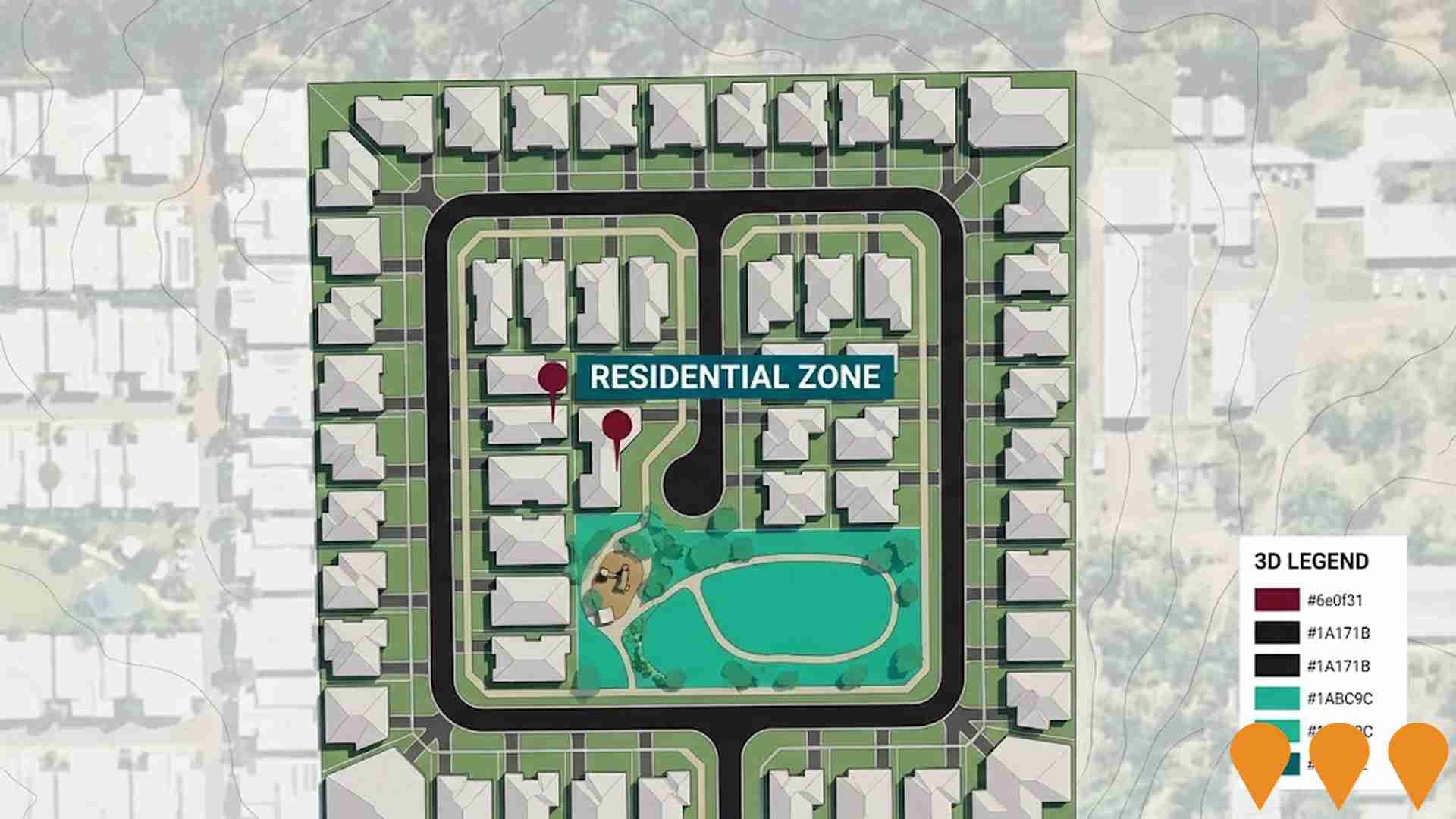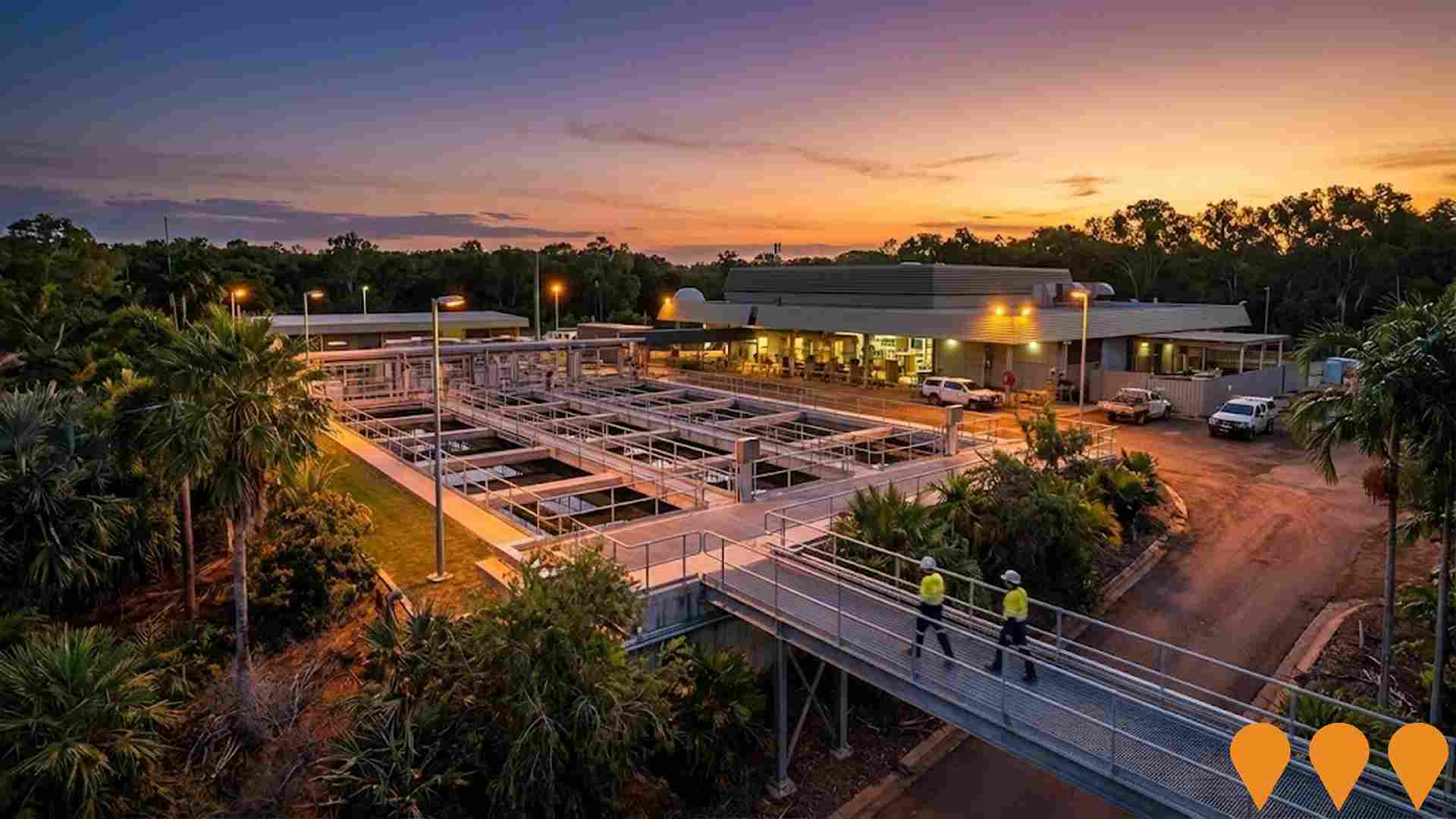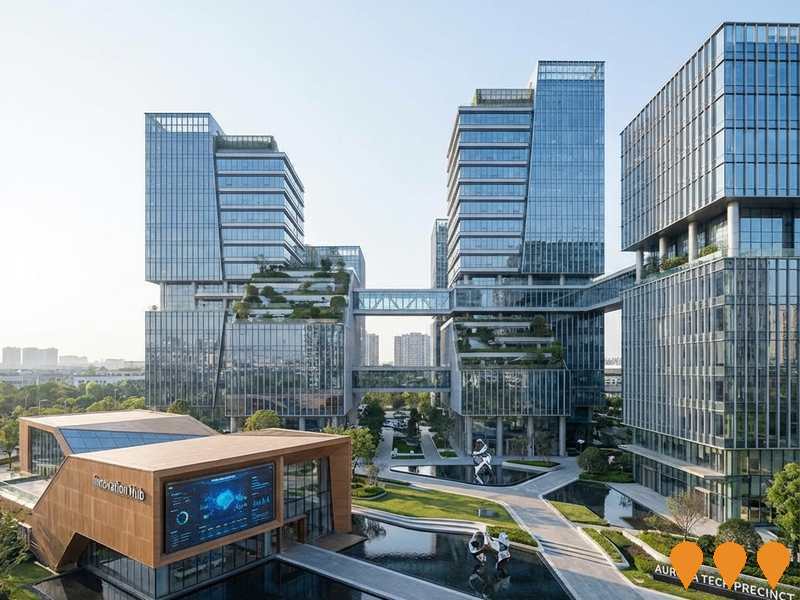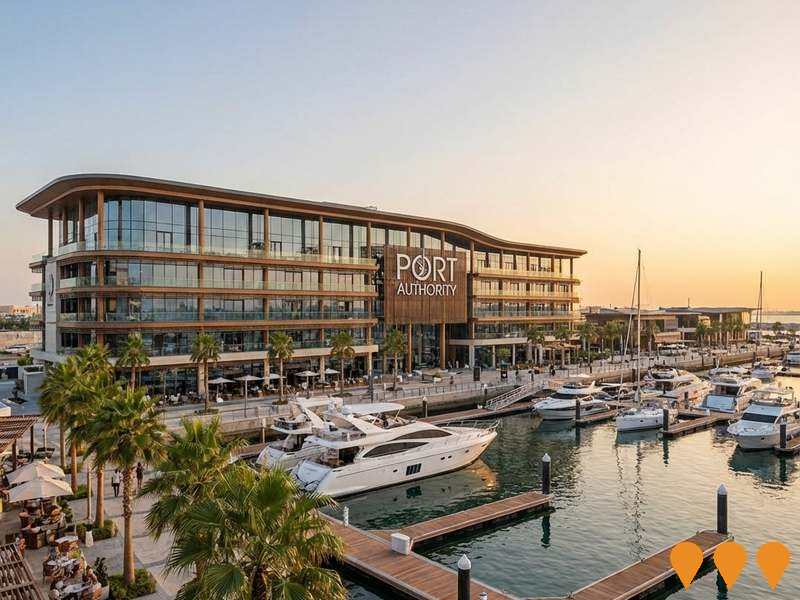Chart Color Schemes
est. as @ -- *
ABS ERP | -- people | --
2021 Census | -- people
Sales Activity
Curious about local property values? Filter the chart to assess the volume and appreciation (including resales) trends and regional comparisons, or scroll to the map below view this information at an individual property level.
Find a Recent Sale
Sales Detail
Population
Malak - Marrara is positioned among the lower quartile of areas assessed nationally for population growth based on AreaSearch's assessment of recent, and medium term trends
As of Aug 2025, Malak - Marrara's population is approximately 4,654. This figure represents an increase of 313 people since the 2021 Census, which reported a population of 4,341. The growth from Jun 2024 to Aug 2025 is inferred from ABS data showing an estimated resident population of 4,656 and one validated new address post-census. This results in a population density ratio of 963 persons per square kilometer, comparable with averages across locations assessed by AreaSearch. Malak - Marrara's growth rate since the census, at 7.2%, is within 0.4 percentage points of its SA3 area (7.6%), indicating strong growth fundamentals. Overseas migration contributed approximately 55.7% of overall population gains during recent periods.
AreaSearch adopts ABS/Geoscience Australia projections for each SA2 area, released in 2024 with a base year of 2022. For areas not covered by this data and post-2032 growth estimation, AreaSearch applies age cohort-specific growth rates provided by the ABS in its latest Greater Capital Region projections (released in 2023, based on 2022 data). Based on current demographic trends, Malak - Marrara is projected to have above median population growth for national statistical areas. By 2041, the area is expected to grow by 837 persons, reflecting an increase of 18.0% over the 17-year period.
Frequently Asked Questions - Population
Development
The level of residential development activity in Malak - Marrara is very low in comparison to the average area assessed nationally by AreaSearch
Development activity data is being compiled for this area.
When measured against Greater Darwin, Malak - Marrara records markedly lower building activity. This scarcity of new homes typically strengthens demand and prices for existing properties. This is also below average nationally, reflecting the area's maturity and pointing to possible planning constraints.
Frequently Asked Questions - Development
Infrastructure
Malak - Marrara has limited levels of nearby infrastructure activity, ranking in the 1stth percentile nationally
Changes to local infrastructure significantly influence an area's performance. Five projects identified by AreaSearch are expected to impact this region. Notable projects include Berrimah North Area Plan, Ludmilla Wastewater Treatment Plant Upgrade, Northern Suburbs Youth Hub, and Leanyer Primary School. Below details those likely to be most relevant.
Professional plan users can use the search below to filter and access additional projects.
INFRASTRUCTURE SEARCH
 Denotes AI-based impression for illustrative purposes only, not to be taken as definitive under any circumstances. Please follow links and conduct other investigations from the project's source for actual imagery. Developers and project owners wishing us to use original imagery please Contact Us and we will do so.
Denotes AI-based impression for illustrative purposes only, not to be taken as definitive under any circumstances. Please follow links and conduct other investigations from the project's source for actual imagery. Developers and project owners wishing us to use original imagery please Contact Us and we will do so.
Frequently Asked Questions - Infrastructure
Australia-Asia PowerLink (AAPowerLink)
The world's largest renewable energy infrastructure project, comprising a 17-20GW solar farm and 36-42GWh battery storage in the Barkly Region, connected via HVDC transmission to Darwin and Singapore. The project received Commonwealth environmental approval in August 2024. It aims to supply up to 4GW of green electricity to Darwin industrial customers and export power to Singapore.

Royal Darwin Hospital Mental Health Inpatient Unit and CSSD Upgrade
New three-storey mental health inpatient facility at Royal Darwin Hospital providing 18 acute inpatient beds plus a 6-bed Stabilisation Assessment and Referral Area (SARA), connected to the Emergency Department via an elevated enclosed walkway. Project also includes major upgrades to the Central Sterile Services Department (CSSD). Managing Contractor: Sitzler Pty Ltd. Works commenced in 2023 with practical completion expected mid-2025.

Darwin Light Rail Stage 1
A proposed mass transit system, likely light rail or rapid bus, connecting Darwin CBD to Palmerston via the Stuart Highway corridor. The project aims to manage future population growth, reduce congestion, and improve connectivity between the two major population centres as part of the long-term Darwin Regional Transport Plan. While currently in the strategic planning phase with no immediate construction funding, the corridor has been identified for future preservation to support a '30-minute city' concept.

Desert Springs Octopus Renewable Energy Program
Majority Indigenous-owned developer pursuing a near-term pipeline of grid-connected solar and battery projects along the Darwin-Katherine Electricity System, with potential to expand into wind and green hydrogen. Partnership includes Octopus Australia with Larrakia Nation and Jawoyn Association to deliver utility-scale renewable energy and community benefit sharing.

Berrimah North Area Plan
Strategic area plan included in the NT Planning Scheme (since December 2014) guiding future land use west of Vanderlin Drive, enabling coordinated commercial, light industrial, employment and residential development with supporting infrastructure. Current NT Budget (2025) includes headworks funding to support implementation across the Greater Darwin region, including Berrimah North.

Ludmilla Wastewater Treatment Plant Upgrade
Upgrade of the existing wastewater treatment plant and associated pumping stations and rising mains, aimed at increasing robustness, optimizing treatment, improving environmental outcomes, and catering for future population growth until 2030. It was the largest sewer project ever undertaken by NT Power and Water Corporation.

Hudson Creek Power Station
12MW natural gas-fired power plant, NT's first privately owned grid-connected gas generation facility. Features 25% lower emissions than average NT gas generators. Part of dual project with Batchelor Solar Farm, creating 162 construction jobs and providing vital grid stability to Darwin-Katherine network.

Marine Industry Park
Marine and offshore industries servicing hub at East Arm, Darwin. Stage 1 planning approval is secured for a purpose-built industrial subdivision near the new Darwin Ship Lift, with expressions of interest open for serviced lots. Existing common-user facilities include an all-tide barge ramp (first point of entry) and a secure hardstand supporting storage and fabrication activities.

Employment
The labour market performance in Malak - Marrara lags significantly behind most other regions nationally
Malak-Marrara has an unemployment rate of 8.4% as of June 2025, with estimated employment growth of 2.7% over the past year. There are 2,362 residents in work, and the unemployment rate is 5.3% higher than Greater Darwin's rate of 3.0%.
Workforce participation is lower at 62.1%, compared to Greater Darwin's 69.7%. The leading employment industries among residents are public administration & safety, health care & social assistance, and education & training. Education & training has notable concentration with employment levels at 1.2 times the regional average. However, public administration & safety employs only 16.9% of local workers, below Greater Darwin's 19.5%.
Employment opportunities appear limited locally based on Census data analysis. In the year to June 2025, employment levels increased by 2.7%, and labour force increased by 2.9%, causing unemployment to rise slightly. In contrast, Greater Darwin saw employment and labour force growth of 2.9% each, with a marginal decrease in unemployment. National employment forecasts from Jobs and Skills Australia (May 2025) project national growth rates of 6.6% over five years and 13.7% over ten years. Applying these projections to Malak-Marrara's employment mix suggests local growth of approximately 6.3% over five years and 13.1% over ten years, though this is a simplified extrapolation for illustrative purposes only.
Frequently Asked Questions - Employment
Income
The area exhibits notably strong income performance, ranking higher than 70% of areas assessed nationally through AreaSearch analysis
Malak - Marrara's median income among taxpayers was $59,769 and average income stood at $66,631 in financial year 2022. These figures compare to Greater Darwin's median of $65,522 and average of $75,260 respectively. Based on a Wage Price Index growth of 12.01% since financial year 2022, current estimates would be approximately $66,947 (median) and $74,633 (average) as of September 2025. According to the 2021 Census, personal income ranks at the 72nd percentile ($938 weekly), while household income sits at the 52nd percentile. The earnings profile shows that 30.4% of residents (1,414 people) fall into the $1,500 - 2,999 bracket, mirroring the surrounding region where 36.7% occupy this bracket. High housing costs consume 16.9% of income, however strong earnings place disposable income at the 51st percentile and the area's SEIFA income ranking places it in the 4th decile.
Frequently Asked Questions - Income
Housing
Malak - Marrara displays a diverse mix of dwelling types, with above-average rates of outright home ownership
In Malak-Marrara as of the latest Census, 63.6% of dwellings were houses, with the remaining 36.4% being semi-detached, apartments, or other types. This compares to Darwin's metropolitan area where 68.4% were houses and 31.6% were other dwellings. Home ownership in Malak-Marrara stood at 25.6%, with mortgaged dwellings at 34.8% and rented ones at 39.7%. The median monthly mortgage repayment was $2,000, lower than Darwin's average of $2,028. Weekly rent in Malak-Marrara averaged $350, the same as Darwin's metro area but below the national average of $375. Nationally, Malak-Marrara's mortgage repayments were higher than Australia's average of $1,863.
Frequently Asked Questions - Housing
Household Composition
Malak - Marrara features high concentrations of group households, with a lower-than-average median household size
Family households comprise 68.9% of all households, including 27.3% couples with children, 24.6% couples without children, and 15.0% single parent families. Non-family households account for the remaining 31.1%, with lone person households at 26.0% and group households making up 5.2%. The median household size is 2.6 people, which is smaller than the Greater Darwin average of 2.7.
Frequently Asked Questions - Households
Local Schools & Education
Educational outcomes in Malak - Marrara fall within the lower quartile nationally, indicating opportunities for improvement in qualification attainment
The university qualification rate in Malak-Marrara is 24.2%, significantly lower than the SA3 area average of 36.1%. This presents both a challenge and an opportunity for targeted educational initiatives. Bachelor degrees are the most common (15.1%), followed by postgraduate qualifications (5.7%) and graduate diplomas (3.4%). Vocational credentials are prominent, with 36.8% of residents aged 15+ holding them - advanced diplomas at 10.7% and certificates at 26.1%.
Educational participation is high, with 33.5% of residents currently enrolled in formal education. This includes 12.5% in primary, 9.0% in secondary, and 4.9% in tertiary education. There are 8 schools operating within Malak-Marrara, educating approximately 1,053 students. The area has varied educational conditions, with a mix of 1 primary, 6 secondary, and 1 K-12 school. School capacity exceeds typical residential needs (22.6 places per 100 residents vs 16.9 regionally), indicating the area serves as an educational center for the broader region. Note: where schools show 'n/a' for enrolments, please refer to parent campus.
Frequently Asked Questions - Education
Schools Detail
Nearby Services & Amenities
Transport
Transport servicing is good compared to other areas nationally based on assessment of service frequency, route connectivity and accessibility
The analysis shows that there are currently 31 active public transport stops in operation within the Malak - Marrara area. All of these stops serve buses. These stops are covered by a total of 54 different routes, which together facilitate approximately 2,901 weekly passenger journeys.
The accessibility of transport is considered good, with residents on average located about 201 meters away from the nearest stop. On average, there are around 414 trips per day across all routes, translating to roughly 93 weekly trips per individual stop.
Frequently Asked Questions - Transport
Transport Stops Detail
Health
The level of general health in Malak - Marrara is notably higher than the national average with both young and old age cohorts seeing low prevalence of common health conditions
Malak - Marrara demonstrates above-average health outcomes with both young and old age cohorts seeing low prevalence of common health conditions. The rate of private health cover is approximately 52% of the total population (~2,438 people), leading that of the average SA2 area but lower than Greater Darwin's 56.7%.
The most common medical conditions are asthma (6.4%) and arthritis (6.3%), with 72.6% declaring themselves completely clear of medical ailments compared to 77.0% across Greater Darwin. The area has 15.9% of residents aged 65 and over (739 people), higher than the 12.3% in Greater Darwin. Health outcomes among seniors are particularly strong, performing better than the general population in health metrics.
Frequently Asked Questions - Health
Cultural Diversity
Malak - Marrara was found to be more culturally diverse than the vast majority of local markets in Australia, upon assessment of a range of language and cultural background related metrics
Malak-Marrara was found to be more culturally diverse than most local markets, with 28.3% of its population born overseas and 25.6% speaking a language other than English at home. Christianity is the predominant religion in Malak-Marrara, comprising 51.2% of its population. Buddhism is notably overrepresented, making up 3.2% compared to the regional average of 4.1%.
The top three ancestry groups are Australian (21.2%), English (18.4%), and Other (14.7%). There are notable differences in the representation of certain ethnic groups: Australian Aboriginal is overrepresented at 12.3% compared to the regional average of 7.4%, Filipino is slightly underrepresented at 4.5% versus 4.7%, and Maori is also underrepresented at 0.8% compared to the regional average of 0.5%.
Frequently Asked Questions - Diversity
Age
Malak - Marrara's population is slightly younger than the national pattern
Malak - Marrara's median age in 2021 was 38 years, which is older than Greater Darwin's median age of 34 but matches the national average of 38. The age group of 65-74 years had strong representation at 9.9%, compared to Greater Darwin. The 25-34 age cohort was less prevalent in Malak - Marrara at 12.6%. Since 2021, the 75-84 age group has grown from 3.5% to 4.9% of the population, while the 35-44 cohort increased from 14.0% to 15.2%. Conversely, the 5-14 age group declined from 14.3% to 12.0%. By 2041, demographic forecasts indicate significant changes for Malak - Marrara. The 45-54 age cohort is projected to increase by 176 people (28%) from 622 to 799. Meanwhile, the 0-4 age cohort is expected to grow modestly by 4% (12 people).





